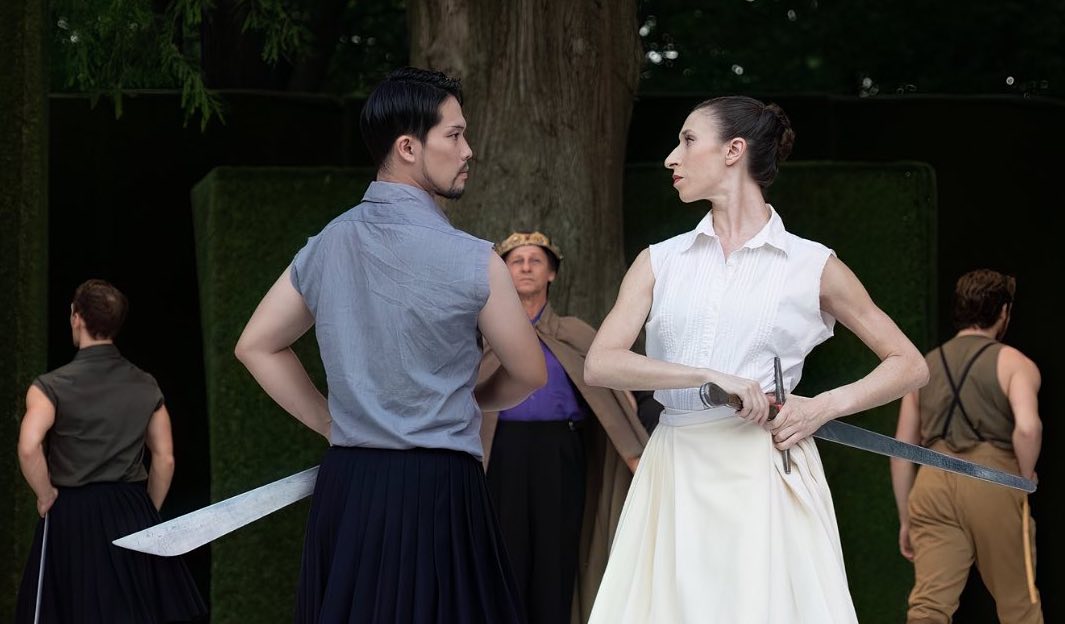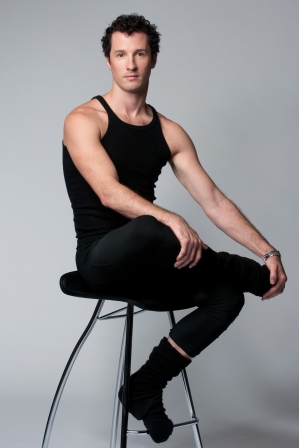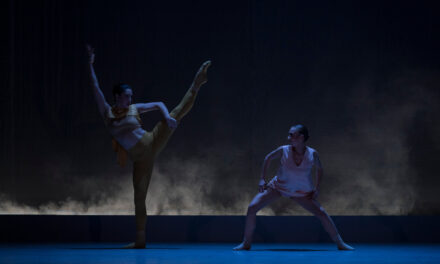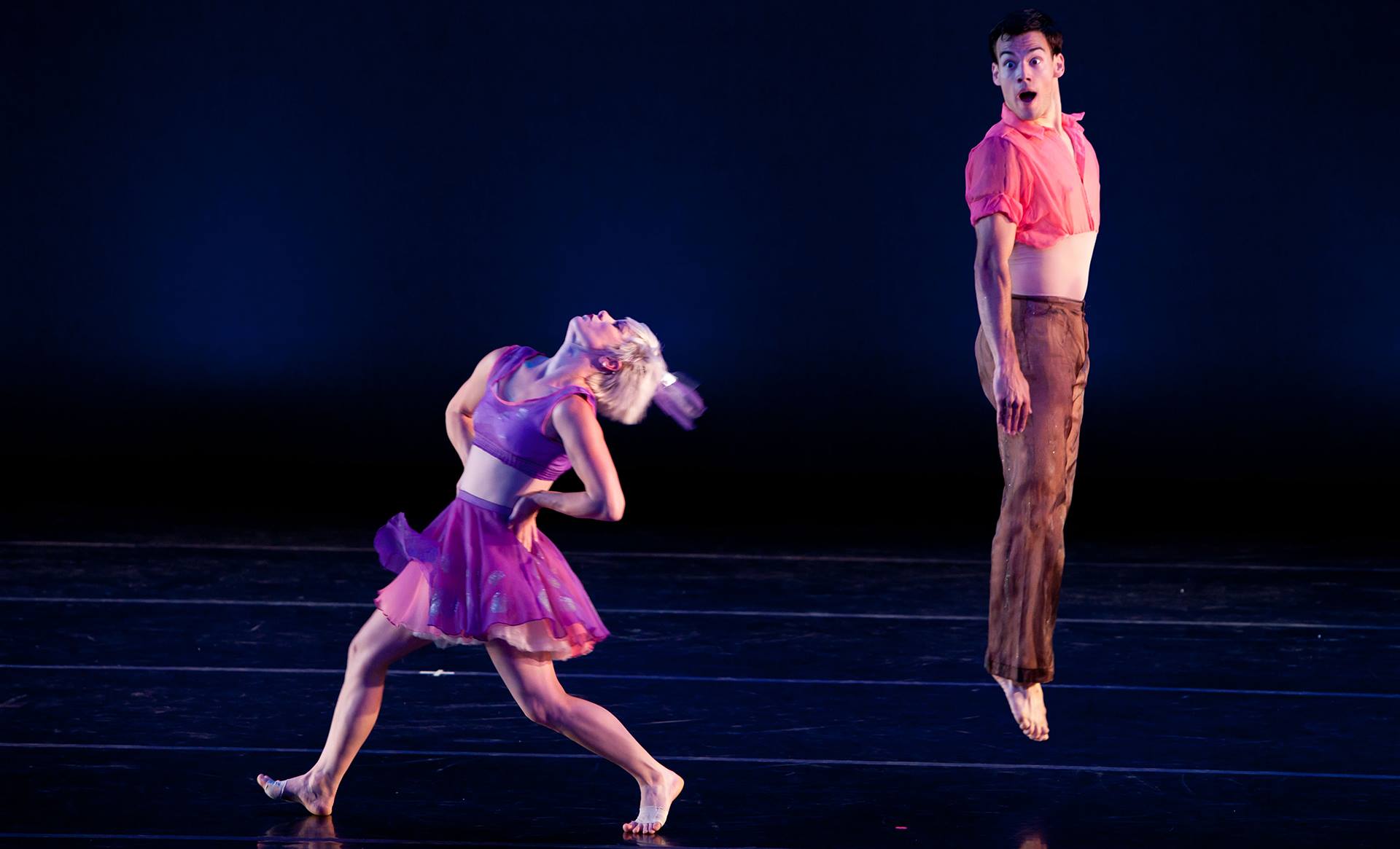Ryo Suzuki & Brienne Wiltsie in Lady M. Photo: Bill Brymer
Lady M
Louisville Ballet with the Louisville Leopards
Choreographed by Roger Creel
A review by Amberly M. Simpson
Entire contents are copyright © 2023 by Amberly M. Simpson. All rights reserved.
This year’s final week of the Kentucky Shakespeare Festival in Central Park featured the Louisville Ballet’s Lady M, their original take on Shakespeare’s Macbeth. In this particular iteration, Lady Macbeth, performed by Brienne Wiltsie, was referred to as simply Beth, and Macbeth, performed by Ryo Suzuki, as Mac (which, amusingly enough, would make their full names Mac Macbeth and Beth Macbeth).
Lady M presents, in many ways, a women-centric and feminist-leaning interpretation of Shakespeare’s Macbeth. Unlike the original tale of Macbeth where Lady Macbeth eventually goes mad and kills herself, the Louisville Ballet’s interpretation has Beth maintaining power and control over Mac through most of the story until, eventually, once Mac is killed, seeking the throne for herself. The three witches aren’t witches at all, but Beth’s three sisters! With these details in mind, the story becomes less about the dangers of power and ambition without restraint, and more about a woman, aided by her sisters, using her influence over her husband to acquire power for herself. It’s women supporting women (except, you know, the women they had to kill in order to get there)!
I appreciated that the choreography allowed the titular role of Beth to be seen as powerful in her femininity. She was featured wielding a sword and as a warrior, but still had choreographic moments that leaned into stereotypical femininity. However, even the most feminine-presenting moments were paired with movement that showed her assertive, manipulative, and unwavering nature. In general, Brienne Wiltsie really did a fantastic job of bringing out the full range of Beth’s character, giving her a depth that made her increasingly deranged grabs for power all the more sinister.
The Three Sisters, performed by Leigh Anne Albrechta, Elizabeth Abbick, and Ashley Thursby, was also a consistently strong presence, clearly possessing an unknown level of supernatural ability as they transitioned between roles as sincere family members, to prophecy givers, to fates holding your life strands (literally) in their hands. The recurring imagery of the cutting of red ribbon, when characters were murdered as part of the prophecy, helped connect the dots between moments in a way that was visually interesting and clear without pulling focus from the action.
While in many ways this production triumphs in centering women’s stories, this messaging felt contradictory at times. For example, the narrative focus of the production tended to slalom from centering on Beth’s experience to that of her husband, as in the original tale. It felt a little like the performance couldn’t pick a side, rather than fully embracing Beth’s experience and perspective. This was especially true in the program synopsis where the description of the plot centers around the actions of the male characters, yet many of the actions taking place on stage are actually being driven by the women. In general, you could tell that the story and description had been adapted from a male-centric story initially and that those narrative threads were still fighting their way to the surface.
All of this said, Ryo Suzuki did a brilliant job of bringing Mac’s character to life, from loving husband, to warrior, to dangerously ambitious power seeker, to guilt-ridden murderer. Despite having a clear amount of virtuosic ability, I found myself most captivated by Ryo’s ability to layer meaning and complexity into simpler, more pulled back moments. For example, the dance of post-murder dissonance by Mac and Beth was very powerful and effective in its use of gestural movement, alongside more twisted and flexed-foot movement. Choreographically, it was stunning, but both Ryo and Brienne’s execution and palpable character tension really made this moment captivating.
The Louisville Leopards were a fantastic choice of collaborators on this production. The limitations of their repertoire, from which choreographer Roger Creel had to choose musical selections, helped drive more unique creative choices choreographically. Some of the musical selections were in direct contrast to the plot, such as the scene where Macduff learns that his wife has been murdered, but the music remains upbeat and lighthearted. This created an ironic, campy feeling that was both compelling and unexpected for a production and story that is typically only dark and eerie.
While the music choices were mostly innovative and highly effective, there were a few moments that failed to produce a clear choreographic intention, the greatest of which was a hybrid of rigid jazz walks, contemporary movements, and a brief tap duet set to “Viva Las Vegas” performed live by the Louisville Leopards. This moment comes after the murder of Duncan and is, to some extent, supposed to represent the blissful ignorance of the kingdom to what has happened to their king. My best assumption was that the tapping (done in ballet shoes, so you could not hear the sounds of the movement) was meant to represent some of the step dances, like the Highland fling, that originate from Scotland. However, if you know your dance history, then you know why this is a problematic way to represent this moment. If you don’t…well, it’s a great day to go down a rabbit hole! TL;DR the ballet world still has a lot of work to do reconciling and addressing their participation and continued perpetuation of cultural appropriation. But I digress…
Additionally, I struggled to resonate with some of the costuming in this production. As a whole, the color scheme wasn’t quite working, most especially with Lady Macduff’s and Liz’s (Banquo’s daughter’s) shirts which were a bright green and light daffodil yellow, in comparison to more muted, dark, and earthy tones for the other characters. Purple was also used to indicate royalty and who was holding power throughout the production, however, I found that the yellow and green of these two shirts actually made the purple less effective where it might otherwise have been very strategic and clear. The distinct difference of these two shirts also made it more challenging to recognize when Liz and Lady Macduff were transitioning into ensemble roles; they simply could not blend.
The skirts worn by the dancers appeared as if they were meant to represent tartans, however, due to their lightweight fabric, and the button-down tops they were paired with on several characters, they appeared more akin to Catholic school girl uniforms. This was aided especially by the Three Sisters who wore what looked like white tennis shoes and crew socks with their skirts.
In the end, the show concluded with a cliffhanger: Beth, with crown in hand, is challenged by Liz who has reappeared, picking the sword of one of Macduff’s fallen soldiers to seek revenge. And that’s it, that’s all you’re left with: two women poised to battle to the death, you decide who will be victorious. Or do you? There was a prophecy, afterall, that declared that “Mac will be king, along with Banquo’s future sons.” Given that Liz’s character is credited in the program as Banquo’s daughter and no sons are listed at all, I am fairly certain that the son reference is a typo. Nonetheless, we know that Banquo’s offspring will take the throne in the end. As such, I am not sure what the added effect of ending on a cliffhanger really brought to the production other than to make it feel somewhat incomplete.
In general, I think that the ballet world as a whole could stand to shorten their productions. Because ballet as an art form has taken great measures to retain its classics, likewise have now-outdated practices in storytelling retained across time. As such, you will find that many ballet productions will contain dances that don’t really further the plot or character development (particularly in the party scenes), making the productions long and sometimes cumbersome. As a whole, Lady M was more concise than most productions I have seen by the Louisville Ballet, but, from a storytelling perspective, I think there was room to shave off 15-or-so minutes of choreography while still maintaining the integrity of the production as a whole. Indeed, by reducing filler and, with it, the mental load of your audience, I would argue that you’re actually increasing the integrity of your production while also making it more accessible to more people. Connecting more directly to Lady M, I would have prioritized bringing the performance to a more decisive conclusion than on providing the opening backstory to how Mac and Beth meet and how “when their first-born son dies young, their world empties.” In a theatrical production, these details are much easier to harken back to and reference than in a Dance production, thus losing the intended effect of giving a driving force behind Beth’s lust for power.
All of this said, Lady M was well-worth the watch and made for a delightful outdoor evening as we prepare to head into the colder months of the year. The Louisville Ballet is, no doubt, facing lots of challenges and uncertainty in the wake of Robert Curran’s resignation and financial challenges that have motivated shifts in their programming. This production serves as a reminder to the community of their resilience on all levels, from performers to designers to administrators. Louisville deserves Dance, and the Louisville Ballet has still got the know-how and the talent to both elevate our city on the world stage and bring something meaningful on a local level. Bravo to all on a strong preamble to what is bound to be a fantastic new season!
Lady M
August 2-6, 2023
Louisville Ballet
Shakespeare Festival in Central Park
C. Douglas Ramey Amphitheater
1340 S. Fourth St.
Louisville, KY 40208
(502) 574-990
kyshakespeare.com
Amberly M. Simpson is a Choreographer, Dancer, and Dance Educator/Advocate originally from Glendale, California. She specializes in Modern, Post-Modern, and Contemporary Dance forms, creating work that is often interdisciplinary in nature to provide commentary on social issues and the human condition. By day, she is the Dance Director and Musical Theatre Co-Director at Noe Middle School, but by night she serves as the Artistic Director of Ambo Dance Theatre. Amberly’s work has been presented at venues such as the American Dance Festival Movies by Movers, the Going Dutch Festival, the Midwest Regional Alternative Dance Festival, and Princeton Research Day where her collaboration with Dr. David Vartanyan received the Impact Award. In 2019, she was honored as one of the Hadley Creatives through the Community Foundation of Louisville, and in 2022 she worked alongside her Dance colleagues in the Jefferson County Public Schools to launch the first ever All County Dance program for the state of Kentucky.





